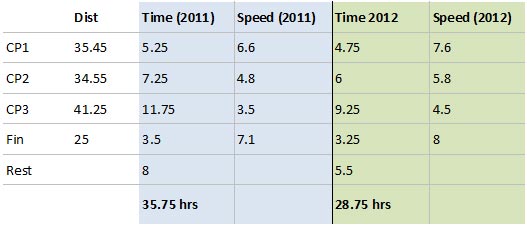So the question is whether or not its reasonable to assume that the changes I've made for this year, other things being equal (i.e. trail conditions, etc), will result in an average gain of 1 mph or more.
Because it feeds my obsession, I've put together some numbers on my race performance from last year, and what a 1 mph increase would do for me this year:

The interesting thing about doing this is that I can put together a goal schedule that I can use during the race. Of course, I suspect that by the time I get to Gateway it will be blown to hell and I'll realize how delusional this sort of planning is. At the same time, I don't think its a bad idea to have some idea of goal times worked out in advance, just to give myself a baseline for how I'm doing. Another thing I would like to do is fall in with a faster group of guys from the start. I feel like that would help to keep a little bit stronger pace going.
Sort of in the same track of over-analyzing data, I have a Google Earth KML file that I have been studying. It was recorded by the race organizer, and includes elevation data. This is the sort of thing that I could easily spend a couple of hours messing with, and not have it make a bit difference to the ride. I'm not 100% sure about the elevation measurements, though. The steepest climb shown is only about 6-5% (which, really, is pretty steep), but my memory is that there are more than a few in the 10-12% range. For comparison I'm thinking of the hill in Ft. Snelling (~11%) and the Myrtle Street hill in Stillwater (12%) - both I can ride but only just barely and only when reasonably fresh. GPS track data usually has all kind of these sorts of issues, and especially over this kind of terrain where the changes are (geographically) short. However, for a general review of the course, its fun to look at and think about.
Other than all that, the general pre-race freakout is beginning to build. Maybe "freakout" is too stong, but the stress level is definitely going up. The weather has been strange - record warm - and my general feeling of preparedness is that I should be doing more. Last week was a busy weekend so I did my long weekly ride after work on Friday. I rode into work with the plan to just keep going west (away from home) for a couple more hours, then ride about three home. When I left my office it was 46F. I went out on the old rail trail, which was about 50% melted off, the rest was a mix of shallow, rutted snowpack and ice. This trail isn't so bad at night when you can't really see how boring it is. It does make for a lot of miles, over 60 total for the day.
The only problem I had was with one of my lights. I put in what I thought were new batteries, but even on low mode the light began to protest after only about two hours. This light doesn't fade, it just blinks off. I turned it back on, then it would blink off again after about a minute or two. I switched to my back-up light and continued on. While thinking about this light, I recall that Eric reported something similar on the Arrowhead last year. I remember thinking at the time that he must have been running it on high beam and that's why it died quickly. Now I'm wondering if there isn't some problem with this light itself. 2-3 hours of battery life is simply not going to work so I need to determine if I need to switch to something else. I do have the helmet light, so that will help as well, but the plan was to improve my overall illumination.
The record high temperatures the past few days have people a bit worried about what kind of race we'll encounter. I'll admit that I also have been contemplating the various possibilities for race types given the weather and lack of snow so far. However, as we descend into a stretch of more normal weather and temps I realize there is still a lot of time before the race for things to normalize. Slightly warmer than last year's -35F wouldn't be the end of the world. :-) And part of what I learned last year is to try not to fret too much about the weather, especially more than 2 weeks out. It will be what it will be, and decisions about what to wear and all that will just have to wait until the night before the race or race morning, since anything before that is just moot. Some are now discussing alternate bike options, but really, I'm not going to change bikes at this point, having never ridden the trail without snow. Really my only option would be my Stumpjumper and the bob trailer, and while not a bad choice, really, for a trail like this, i just don't think I'd risk the possibility of snow during the race no matter the forecast. And there is bound to be small amounts of snow on parts of the trail. A 1 or 5 mile stretch of old, soft snow would kind of suck without fat tires.